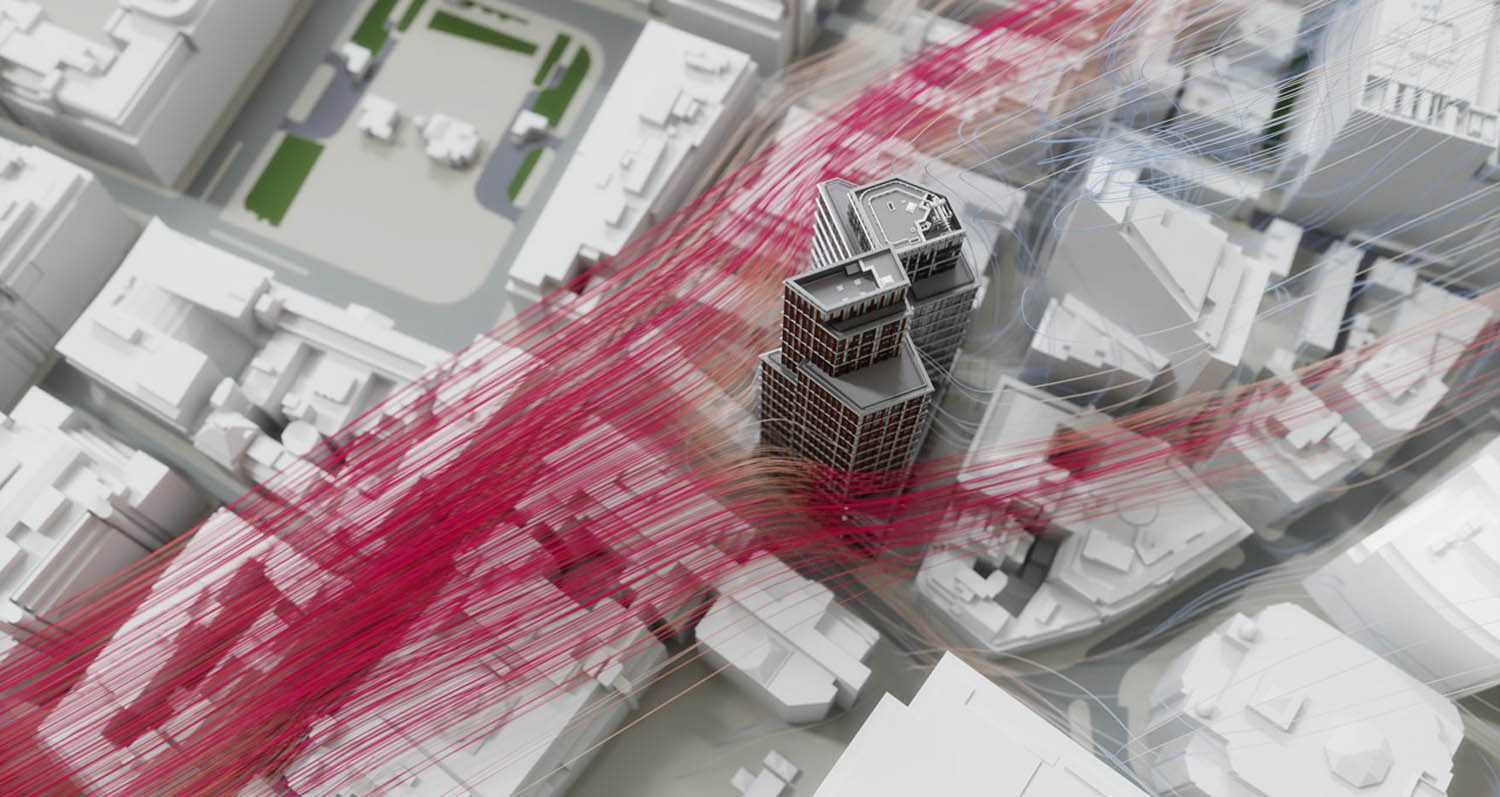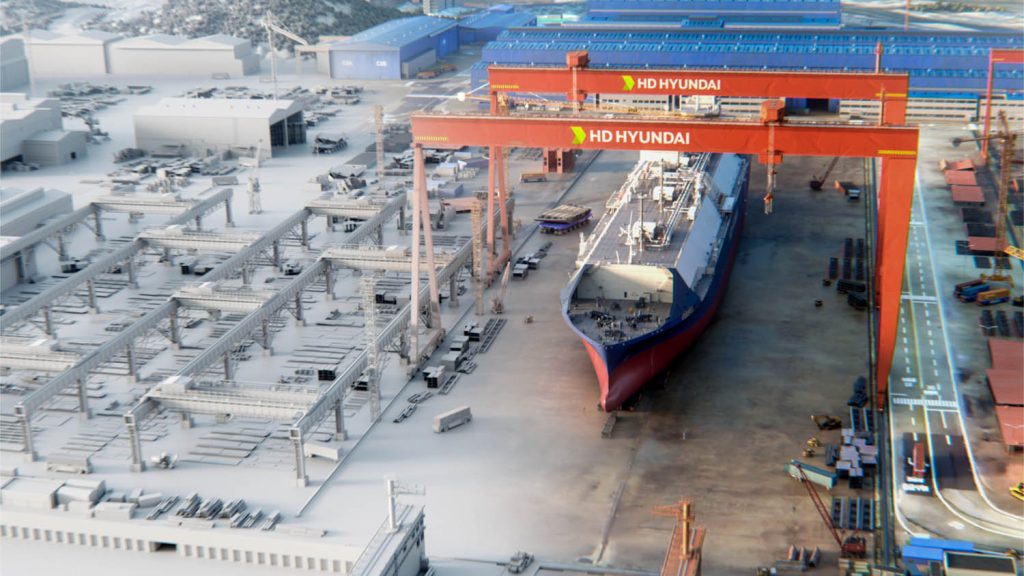When Nvidia first launched Omniverse, it was presented as a collaborative hub for users of CAD, BIM and viz software. With new Cloud APIs, the company is now extending the reach of Omniverse beyond the core demographic of designers and artists, writes Greg Corke
In AEC, an industry that continues to face significant challenges when it comes to data interoperability, some firms are using the Nvidia Omniverse platform as a key enabler for collaboration.
In Omniverse, everything centres on OpenUSD, an open-source 3D scene description that was originally developed by Pixar for 3D content creation and interoperability between tools.
Global architecture firm Kohn Pedersen Fox (KPF) uses Omniverse USD Composer to seamlessly share data in real time between its key authoring tools — Rhino, Revit, Grasshoppper, and Unreal Engine. In short, it breaks down silos.
Omniverse is not just for collaboration, however. It provides a powerful environment for visualisation. Powered by Nvidia RTX GPUs on desktop or in the cloud, AEC firms have ready access to technologies including real time ray tracing for photorealistic rendering, and one click VR/AR for presenting projects to clients.
In a recent presentation at Nvidia’s GTC conference, KPF’s Andy Christoforou, applied research: project innovation manager, and Joe Brennan, senior computational designer, explained how Omniverse has made it much easier for KPF to evaluate massing options for its architectural projects.
Rather than producing separate visualisations, the team brings together data from multiple sources inside the visually rich Omniverse environment. 3D concept models are combined with wind simulation data from Simscale, and contextual 3D city data from geospatial data platform Cesium, all in real time.
The cloud attraction
In AEC, most of the major software developers have a long-term strategy to move their customers to their respective cloud platforms. Autodesk has Forma, Bentley Systems has iTwin, Hexagon has Reality Cloud Studio. There are several others.
Each platform is not just about centralising data; it’s about building optimised collaborative workflows around that data and, in the future, using AI to obtain valuable insights from that data.
Of course, software developers ideally want customers to remain in their platform as long as possible. Furthermore, AEC firms don’t necessarily want to build workflows around multiple platforms.
To some extent, Omniverse pushes against this. It also has a key focus on users of CAD, BIM and viz software; less so on the many other people involved within a typical AEC project.
In order for Nvidia to play a bigger role as these AEC cloud platforms grow in stature, the company recently released a series of Omniverse Cloud APIs, coming first to Microsoft Azure.
Rather than making Omniverse the centre of everything, Nvidia is enabling software developers to integrate key Omniverse technologies into their respective platforms. It means their users can continue to work in a familiar environment, workflows remain the same, and data is stored in one central repository.

In its simplest form, software developers can embed Omniverse-powered viewports into their platforms, delivering ‘instant’ real-time physically based rendering – processed on GPUs in the cloud with pixels streamed to a client device. Software developers can also use the APIs to connect Generative AI tools into their existing apps, as well as a range of workflow tools for OpenUSD data.
Several software developers have already come on board with Omniverse Cloud APIs, including Ansys, Cadence, Dassault Systèmes, Hexagon, Microsoft, Rockwell Automation, Siemens, and Trimble. Some Omniverse API developments are at a more advanced stage than others, and details are still thin on the ground. AEC Magazine caught up with Hexagon and Siemens to find out more.
The new reality
Hexagon is in a relatively unique position in the world of design and engineering software in that it serves both AEC and manufacturing sectors.
In AEC, the focus for Omniverse is on Reality Cloud Studio, based on Hexagon’s HxDR platform. Reality Cloud Studio brings together reality capture data from multiple sources — point clouds, photogrammetry and reality meshes — for visualisation and collaboration.
Reality Cloud Studio already places a big emphasis on visualisation, but Hexagon is using Omniverse to take this to new levels. As Frank Suykens, senior VP visual computing at Hexagon told AEC Magazine, Hexagon will use Omniverse to bring ‘emotion’ into projects, adding digital humans to presentations to help convince stakeholders.

BIM models from tools like Autodesk Revit can also be brought in and placed in the context of a city model. Omniverse can then do the photorealistic rendering.
Work that would typically take days in a product like blender or Maya will now be ‘automated’ with Omniverse, he said.
For standard visualisation built into the core of Reality Cloud Studio, processing is done on the client device — desktop, laptop or tablet — but there is a limit to how realistic you can make things if you don’t have a powerful workstation.
With Omniverse Cloud APIs, all the rendering is done in the cloud, using Nvidia GPUs, with pixels streamed to the client device. HxDR currently runs in AWS but for Omniverse Cloud services, Hexagon will either use Nvidia’s hosted version in Azure or it will be deployed in AWS.
Of course, this means that every time someone wants to do an Omniverse visualisation, they have to pay for GPU cloud hours. According to Suykens, this would be bundled into a subscription with usage-based pricing.
Scan-to-BIM
Hexagon’s collaboration with Nvidia goes beyond visualisation. Suykens told AEC Magazine that the plan is to bring AI and semantics into Reality Cloud Studio to transform scans into BIM models, using Nvidia GPUs for the AI computation.
Reality Cloud Studio can already do automatic classification, recognising patterns in a point cloud or mesh and classifying the data to say ‘this is a table, this is a window, these are the walls.’
The next step is true scan-to-BIM, turning reality models into BIM objects, delivered in IFC format or possibly OpenUSD. “We’re first looking at walls, but then, in time, we want to create a semantic model from the scan, fully automated,” said Suykens.
For AI training, Hexagon is using a combination of real-world data from the HxDR platform and synthetic datasets generated using Omniverse.
Suykens explains that synthetic datasets can be extremely powerful because the classification for the point cloud or image data that is generated is already known. With real world data the classification needs to be done manually, which can be very labour intensive.
Find many more articles like this in AEC Magazine
👉 Subscribe FREE here 👈
Making visualisation pervasive
Siemens, a major player in the manufacturing software industry, is starting to dip its toes in AEC . However, it’s the way in which the company is adopting Omniverse Cloud APIs that’s most interesting, potentially offering a glimpse into what could be coming from AEC software developers.
Siemens is starting with Teamcenter X, its cloud-based product lifecycle management (PLM) platform, offering Omniverse RTX rendering directly inside the software, so users can visualise massive engineering datasets, interactively and photorealistically with real time ray tracing. At Nvidia GTC, the company gave a demonstration of a colossal 7-million-part ship model from HD Hyundai, visualised in real time, powered by GPUs in the cloud. The demo also showed the use of Generative AI, using text prompts, such as ‘atlantic ocean waves, remote photography, ocean, sea, morning sky’ to generate 3D objects or HDRi backgrounds to visualise the model in context.
The interesting takeaway here is that PLM software, just like AEC data management / collaboration software, needs to be used by all different types of users. Providing a beautifully rendered viewport with buckets of GPU acceleration from the cloud, on-demand, instantly makes 3D model data accessible to everyone and not just those with powerful local workstations.
With Omniverse RTX rendering, you also get the ability to create beautiful visualisations relatively easily. In theory, this could mean marketing departments can create their own visuals, rather than having to rely on a designer or engineer powering up Siemens NX, the 3D CAD software, and NX Ray Traced Studio, the visualisation tool.
Siemens has plans to extend Omniverse APIs into other tools, including Siemens NX which was recently made available as a cloud service (Siemens NX X). Siemens NX X can be deployed in two ways: on the desktop, where it uses local CPU and GPU processing, and in the cloud where it runs on cloud workstations and pixels are streamed to the local device.
Siemens is currently working with Omniverse Cloud APIs to put an Nvidia RTX-powered viewport directly into Siemens NX X, delivering real time ray tracing on-demand, powered by cloud GPUs. The RTX viewport will co-exist alongside the current OpenGL viewport, so Siemens will not have to completely re-architect the software using modern graphics APIs like DirectX 12 or Vulkan, which is a huge undertaking.
We wonder if AEC software developers could be doing something similar, although it’s unlikely to be Autodesk as the company is currently developing a new viewport system based on Hydra and USD.
Getting connected?
Trimble was among the names of AEC software firms adopting Omniverse Cloud APIs, but is currently holding its cards close to its chest. The company has simply stated that it is enabling interactive Nvidia Omniverse RTX viewers with Trimble model data. Reading between the lines, this sounds like Trimble could have plans for Trimble Connect, its AEC-focused collaboration tool, which is available for Windows desktop, browser, and mobile (iOS and Android).
Trimble is certainly buying into USD for AEC collaboration. It recently joined the Alliance for OpenUSD (AOUSD) and improved import and export for USDZ files in Trimble SketchUp 2024 to enhance interoperability between its popular push / pull modelling tool and Nvidia Omniverse, as well as other tools such as Epic Games Twinmotion.
The cloud future
With Omniverse Cloud APIs, Nvidia is extending the reach of its Omniverse platform, putting RTX visualisation into the hands of many more users, especially those that previously would have been excluded because of underpowered local hardware. The emphasis is on photorealism, but with powerful GPUs in the cloud, far outpacing those in your average desktop, laptop or tablet, Omniverse Cloud APIs could also help all different types of users view larger, more complex 3D models in general.
Of course, cloud processing doesn’t come cheap and AEC software firms will need to pass on costs to customers. If demand is there, however, paying for GPUs on demand could be a more cost-effective way of extending the reach of valuable 3D assets, the alternative being providing everyone with powerful workstations, which may be underutilised a lot of the time.
For Nvidia it looks like a win, win. More use of Omniverse, a gateway into the broader Omniverse platform, and more use of GPUs, wherever they might be.
Main image credit: Omniverse RTX rendering is available directly inside Siemens Teamcenter X, the cloud-based product lifecycle management (PLM) platform, so massive engineering datasets can be visualised interactively and photorealistically with real time ray tracing






